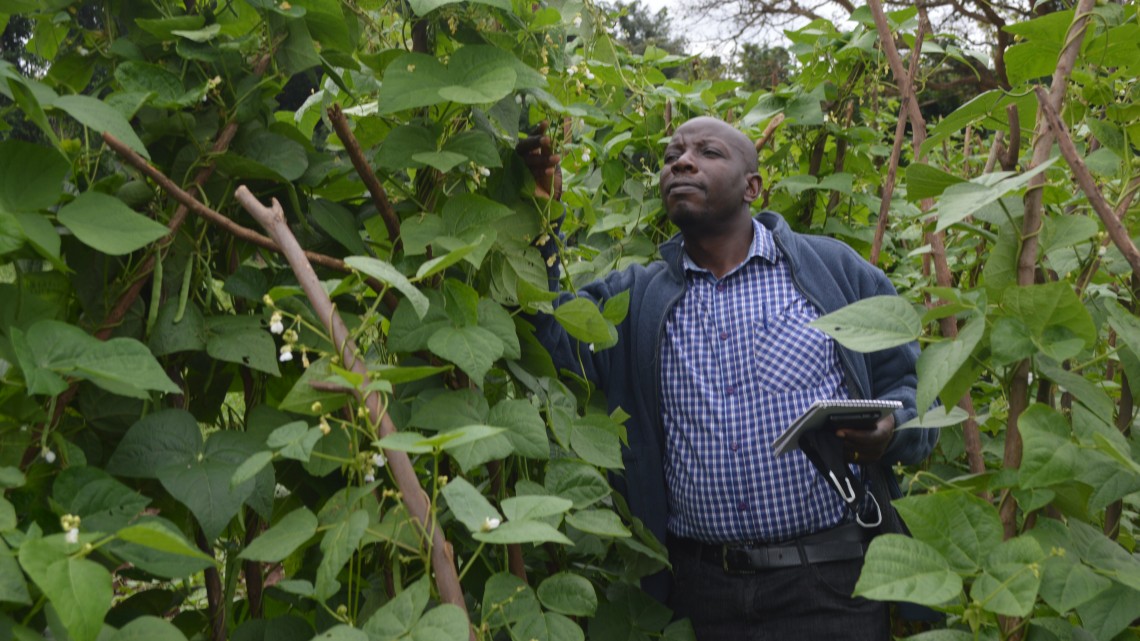
Stanley Nkalubo, a plant breeder and geneticist at the Ugandan National Agricultural Research Organization, assesses common beans.
News directly from Cornell's colleges and centers
Ugandan breeders use genomic selection to boost health and satisfy customers
By Kelly Merchan
In Uganda, 90% of a population of more than 44 million people relies on common beans as their primary source of protein. Ugandans depend heavily on beans for food security, with a higher annual consumption rate (40kg/capita) than anywhere else on earth. While beans are rich in protein, it is not reaching its potential to deliver micronutrients like zinc and iron. The human impacts are severe. In Uganda, 40% of pregnant women are anemic and 38% children under the age of 5 are stunted, over half of which are due to a deficiency in those two nutrients.
Plant breeders in Uganda are taking a new approach to boost the levels of zinc and iron in common bean. Led by Stanley Nkalubo, a plant breeder and geneticist at the Ugandan National Agricultural Research Organization, the research combines genomic selection with attention to social dynamics to chart a new path for food security in Uganda. This “Quick win” project of the Feed the Future Innovation Lab for Crop Improvement is housed in the College of Agriculture and Life Sciences’ Department of Global Development.
Beans take roughly 90 minutes to up to three hours to prepare, a task more often done by women. Cooking not only takes large amounts of time, water and fuel, but also results in a huge loss of micronutrients during the process. Through genomic selection — the analysis of a plant’s genetic makeup to identify the most desired properties — the breeders are developing models for quantitative traits across 532 different lines. In this case, the breeders are prioritizing cooking time, iron and zinc levels, and yield.
“The goal of our research is to help African women and children by having a shorter cooking time, which will provide women with more time for other activities,” said Nkalubo. “By increasing iron and zinc micronutrient availability, this research could especially support pregnant women and children under the age of 5.”
Early results show a negative correlation between cooking time and the amounts of zinc and iron in the food. In other words, when breeders raise the amount of zinc and iron in beans, required cooking times go down. These genetic correlations are promising, and a selection index will be developed to optimize gains across the traits.
This research and the development of a new genomic selection tool will be beneficial to bean breeders around the globe. Technical advances will allow for improved selection of parental lines for future crosses and better phenotypic predictions of new germplasm and new environments. And the potential for progress doesn’t stop there: the breeders are developing a quantitative genetics course that will train breeders across Africa and beyond about basic quantitative genetics concepts and statistical methods for genetic data analysis with a focus on genomic selection.
“Our hope is that the outputs of this research will be beneficial to bean breeders and enable the selection of parental lines for future crosses and prediction of phenotypes for new germplasm and new environments,” Nkalubo shared.
Kelly Merchan is a communications specialist in the Department of Global Development.
This article originally appeared on the Feed the Future Innovation Lab for Crop Improvement website.
Media Contact
Get Cornell news delivered right to your inbox.
Subscribe
